Desmond Briscoe, Organiser RWS, welcomed me and gave me a tour of the facilities. The main changes since my last visit were the appointment of an additional composer, David Cain, with a third studio acquired. John Baker had Room 11, Delia Derbyshire and Brian Hodgson shared Room 12, and David Cain was in the original Room 13.
My job would be to assist the composers.
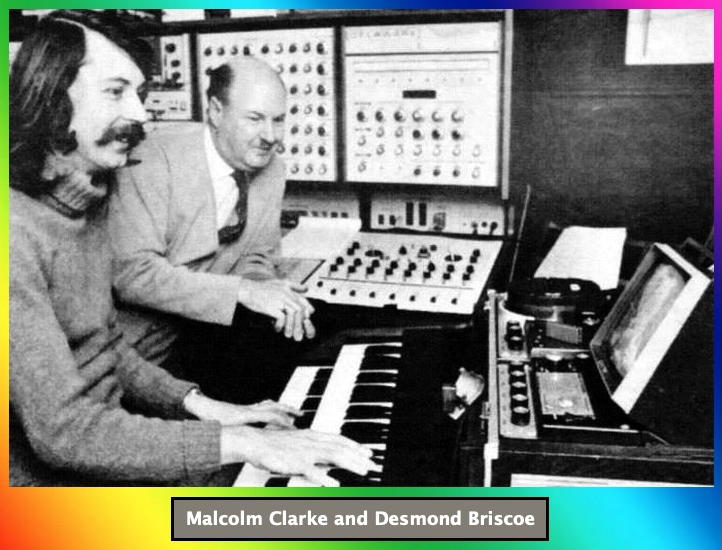
There was little new with regard to equipment or facilities. Synthesisers, personal computers, digital recording and samplers were yet to be invented. The number of Jason 'kit' oscillators had grown to twelve and these could be keyed on and off through a one-octave keyboard. (These were often tuned to a chromatic octave calibrated from the frequency counter). Each key had basic 'on' and 'off' envelope shaping.
From redundant stock there was:-
Frequency Counter
Albis One-Third Octave Filter [graphic equaliser] 20 Hz - 20 khz*
Muirhead Decade Oscillator
Brüel & Kjær (B & K) FM Oscillator , which we called the 'Wobulator'
[*Other sources indicate this and other items were purchased as new.]
These items can be seen in the photograph:
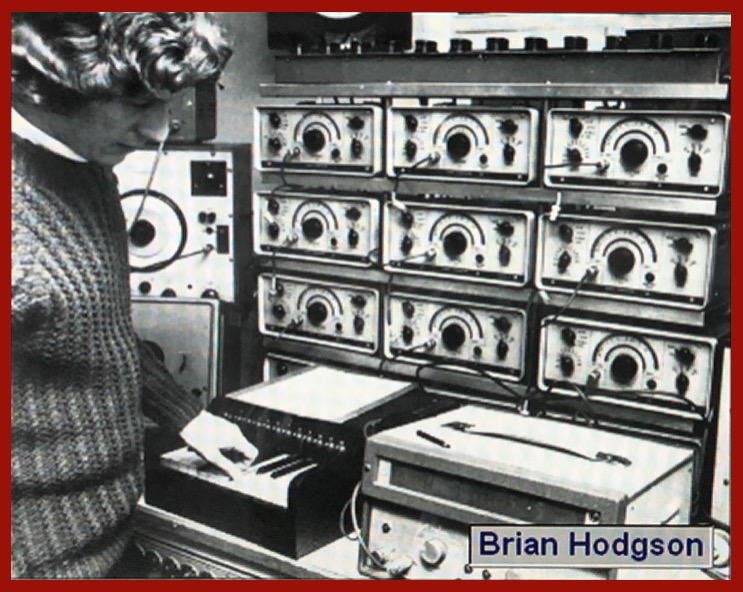
DAVE YOUNG

Dave Young was the resident engineer. He had made many small and useful mechanical devices, typical of which was the DNFW (DO NOT FIDDLE WITH). This was a spring-loaded arm on the end of a height-adjustable stand. On the end of the arm was a tape guide.
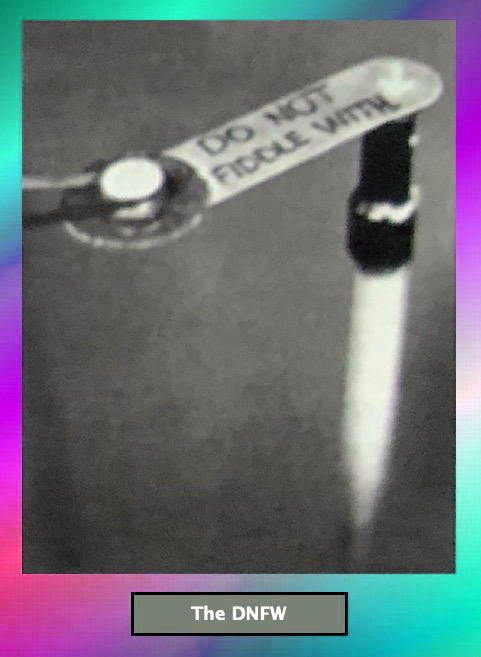
Tape in the form of a loop was played by a conventional tape recorder, whilst being kept under tension via the tape guide. Visitors to the Workshop found these irresistible to play with, and in the process many springs were broken. A big notice was painted on each arm to warm against this.
Dave had been a prisoner of war [in Europe during WWII] and this had taught him to look upon all 'junk' items as potentially useful. The 'crystal palace' was a typical invention. An early 'sequencer', it was designed to link together up to sixteen sources.

Each source was scanned to an output using a rotating capacitor [vane], the speed of which was variable over a very wide range. It was made from used tobacco tins, an EMI dictation machine motor and some Ferrograph rubber wheels. The original model was housed in an old Art Deco radio case. When this became a popular device, Desmond requested three more to be made. Dave had found a sheet of Perspex in a skip and this was used to make the new cases, and gave them their name*.
[*From the glass and iron structure used for the Great Exhibition of 1851].
NEW WORLDS

The most important improvement in technical facilities was the standardisation of recording facilities in each studio. This meant that in the event of a technical emergency work could be moved from one studio to another. Each studio contained three Philips full-track tape recorders and one specially-modified Leevers-Rich tape recorder*. This had a DC capstan motor fitted, which could chromatically vary the record and playback speed of the tape.
[*Only Room 12 had this machine.]
Nearly all compositions were made by tape manipulation. Individual sounds were recorded and stored as a tape loop. These were re-pitched by playback speed variation on the Leevers-Rich and the re-recorded tape cut together using razor blades and sticky tape to make individual tracks. Each sound could be pitched over four octaves without re-recording. The duration of each note depended how long its cut piece of tape was. The standard recording speed was 15 inches per second (ips).
Three tape tracks assembled in this way could be synchronised by starting the three Philips machines together. Each machine had different starting characteristics. To adjust for this a quarter of an inch of 'line-up' tone (1kHz) was cut into the leader (blank portion) of each track, two seconds before the start. Each machine was set up with this blip of tone set at the same position - about 15 inches before the replay head.

The machines were then started simultaneously, using Dave Young's 'remote start box'. If a single blip of tone was heard, the machines were running together. If a blip was heard early or late, the starting position of the offending machine was reset to accommodate for this. Once started together, the Philips machines would run in synchronisation for at least five minutes! Blip tones of differing pitch were often used to help identify the offending machine.
A typical example of a composition made using these techniques is the signature tune for 'New Worlds' by John Baker, in which he uses the sound of the palm of a hand hitting an open shampoo bottle ( bloop! ):

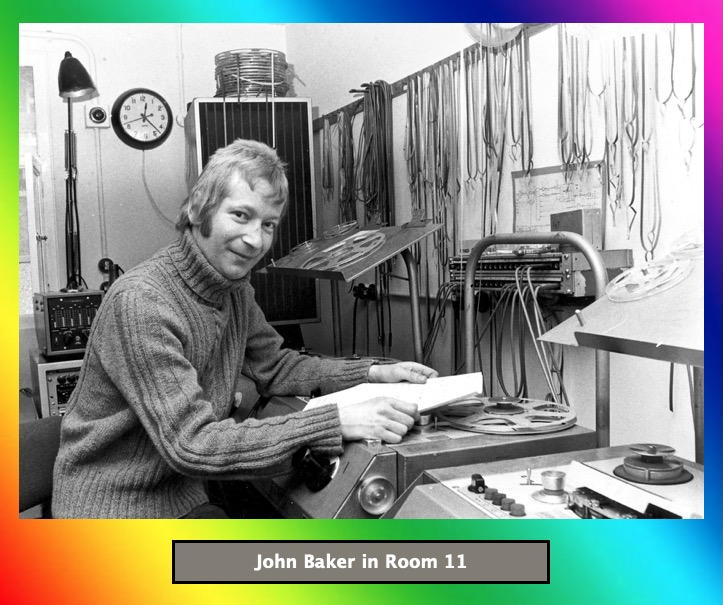
In the photograph, John is seated at a Philips tape recorder. On the wall behind are dozens of tape loops, hanging from brass 'cup hooks', containing his library of sounds.
GOLDEN SANDS
There was one piece of electronic equipment, which I found very interesting. It had been designed and made by BBC Engineering Research Department and was called a PA stabiliser. Its purpose was to overcome the problem of acoustic feedback, which occurred when sound in a hall was amplified and played back, via loudspeakers, to the hall audience, in order to reinforce the sound. If the sound from the speakers reached a certain level at the microphone, it would be re-amplified and the sound system would go into an uncontrolled 'howl round'.The way to avoid this had been to turn down the volume of the loudspeakers in the hall, but this often resulted in the sound not being loud enough for the audience.
The 'Public Address Stabiliser' overcame this problem by modulating the sound and demodulating it at a slightly different frequency. By adjusting the 'shift' control it was possible to move a howl-frequency antinode at the microphone until it became a node*. The audience would not be aware of the slight pitch change and it was not necessary to lower the public address volume.
[*A node is a point along a standing wave where the wave has minimum amplitude. For instance, in a vibrating guitar string, the ends of the string are nodes]

What fascinated me, however, was the effect when a sound was recombined with itself after being fed through the PA stabiliser. The resulting sound was a highly-controllable phasing.*
[*Phasing is an effect where a pitched-changed sound is mixed with the original, producing peaks and troughs in the output signal, which are not necessarily harmonically-related. Flanging, which is similar, uses a fixed delay across the frequency spectrum, such as that introduced by a tape recorder, creating a 'comb filter' effect, with peaks and troughs that are in a linear harmonic series.]
Here is an example of the PA stabiliser in use - 'Blue Veils and Golden Sands' by Delia Derbyshire:
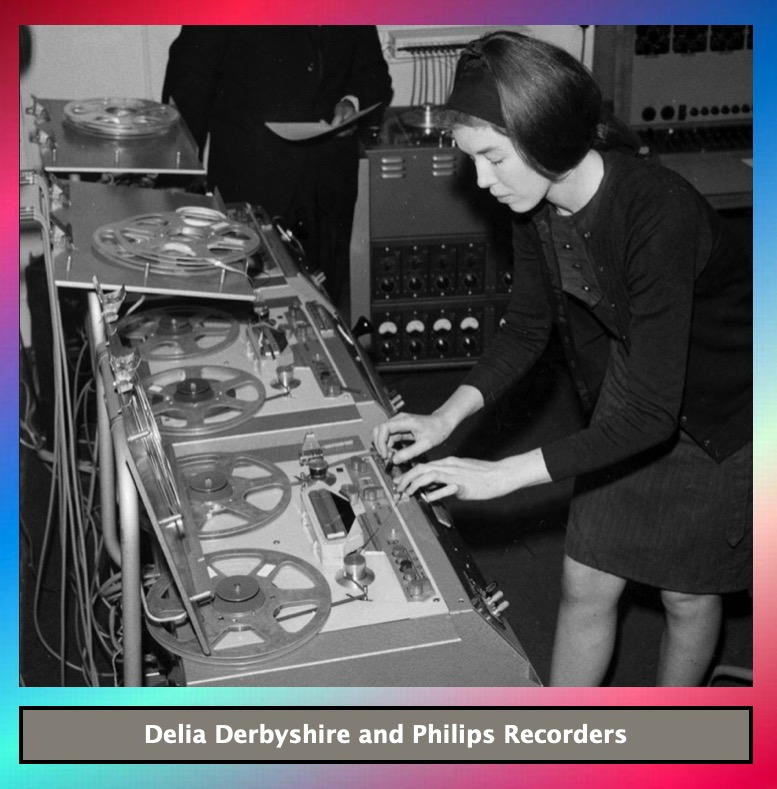
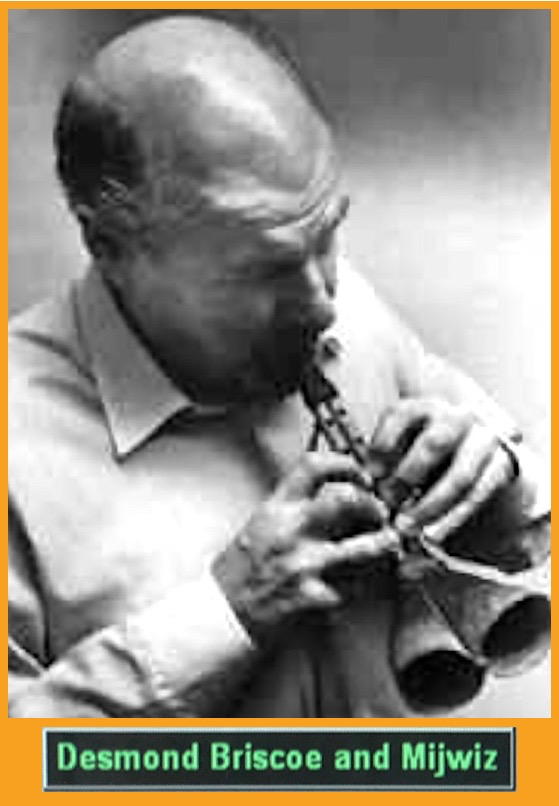
Delia had just composed the 'Chronicle' signature tune, and in some of the accompanying programmes she needed to create the atmosphere for huge desert landscapes. For this she used the normal Workshop resources, with two additional sounds - an edited tape loop of a mijwiz, an Arabian double-reeded pipe and the recorded sound of an eighteen-inch piece of duralumin, hit with a soft stick and processed through the PA stabiliser to give a slow-shifting 'phasing' to the sound, similar to a mirage in visual terms.
GREAT ZOOS

Almost before I knew it, my three-month attachment was nearly over, and I had not worked with any of the composers. I mentioned this to Desmond Briscoe, the Organiser. He said that it was unfortunate, but it was in the nature of the Radiophonic beast. They were all loners and more than capable of carrying out any aspect of the work. I thought about this and realised that it was this complete nature of what they were doing that appealed to me. It was just like painting. There was no intermediary between the idea and the end product.

A few days later I arrived early in the morning to see written large on the notice board, in red felt tip pen, the message above. Desmond explained that Delia had a problem. She had been commissioned to compose a signature tune for the television series 'Great Zoos of the World' and had been working on this all the previous day and night, and had become stuck. The situation was serious, because the producer of the programme was on his way to the Workshop from Bristol, and was due to arrive at two o'clock. I immediately went in to see Delia, and the best suggestion I could make was that we had breakfast.
While we ate, Delia gave me a clear outline of what she was doing. The main problem came from the fact that she had agreed with the producer to create the signature tune using only real animal sounds. She had found a good bass line from a recording of an otter and had a lovely camel whooping a perfect cadence, ideal for the end. The lion roar, much to her surprise, had failed completely. She had requested a copy of the splendid lion roar which accompanied the laurel-wreathed lion's head logo of MGM films. Like so many visually associated sounds, on its own it was very disappointing.
My contribution was to offer to do the roar for her. This I performed on a full stomach at about six inches away from a PGS ribbon microphone. The recording complete with bass tip-up (due to a characteristic of ribbon microphones when used closely) was lowered by about half an octave by slowing down the tape recording on playback. The result was wonderful and frightening! Delia's enthusiasm returned. We worked frantically until the producer arrived. Fortunately, he was half an hour late and we had just finished. His only question was how soon could he have a copy, as the first programme was being transmitted that week.

SYNTHESISERS: THE EMS VCS3
lt was at this time (1970) that equipment specially made for sound generation and manipulation first became available at the Radiophonic Workshop. In the previous ten years considerable progress had been made in the design and manufacture of transistorised components. The possibility of producing many transistors and their linking components on a single piece of silicon had resulted in the integrated circuit, which had many advantages over its discrete component alternative. It was small. reliable, produced little heat and, above all, was cheap.
The concept of 'voltage control', in which the variable parameters of a device could be controlled by a voltage, meant that one device could be simply set up to control another. Robert Moog had suggested, in a paper to the Audio Engineering Society of America in 1958, the possibility of a voltage control system for the generation and control of sound. When the voltage-controllable integrated circuit amplifier called the IC 741*, became available, the seed was set for the birth of the synthesiser. Moog had already made keyboard controlled synthesisers, which had become famous for the quality of their low pass filters, especially in producing plucked bass sounds.
[*Strictly speaking, the 741 was an operational amplifier, but with additional components it could be used in voltage-controlled circuitry, as in the example below:]
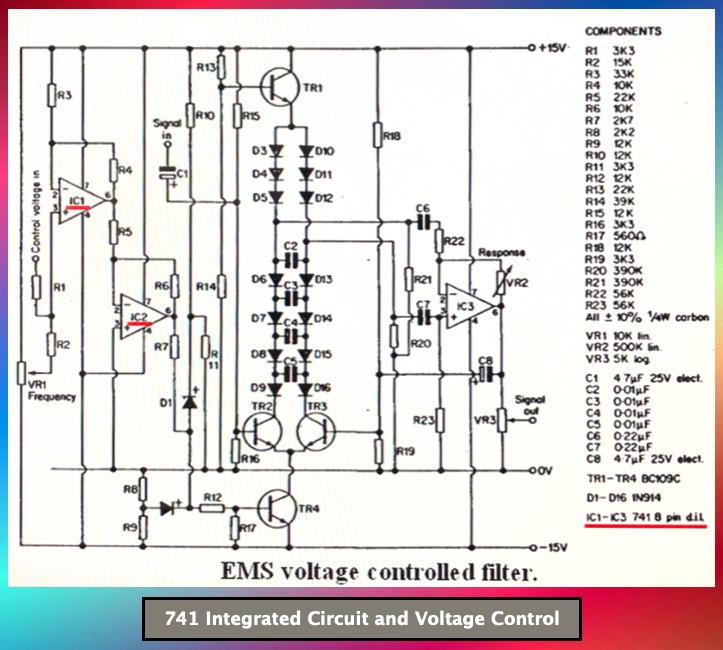
The Workshop had not shown much interest in this development, probably because its tradition was firmly rooted in the classical concrète tradition. When Peter Zinovleff set up Electronic Music Studios (London) and produced the VCS3, a small voltage-controlled synthesiser, we became very interested. We had on our doorstep a manufacturer who was making state of the art synthesisers and who was interested in our ideas.

VCS3 & 'SYNTHI A' SPECIFICATIONS
Oscillator 1: Range: 0.5Hz-20 kHz. Output: Sine (with variable shape) and sawtooth.
Oscillator 2: Range: 0.5Hz-20kHz. Output: Square and triangle. Shape control gives variable pulse width and rising or falling ramps.
Oscillator 3: Range: 0.025Hz-500Hz. Output: Square and triangle (shaping as per Oscillator 2).
Noise Generator: White and variable coloured noise.
Filter: Range: 5Hz-15kHz. Low-pass with variable resonance and sine wave oscillation. Oscillator: Cut-off Rate: 15dB/octave max.
Ring modulator: Transformerless integrated circuit design. Input Rejection: 60dB
Envelope Shaper: A programmed variable gain amplifier of trapezium format with analogous voltage output. Timing: Attack: 2ms-1s. On: 0-2.5s. Decay: 2ms-15s. Off: 10ms-5s + recycle inhibition. Triggering Modes: Via +5V from keyboard socket, manual trigger from attack button, external signal input level threshold detector or self-triggering in recycle mode. Decay time is voltage-controllable from patchboard.
Reveberation: Dual spring-line unit with delays of 25ms and 20ms. Max reverb time: 2s. Reverb-to-direct ratio voltage-controllable from patchboard.
Joystick controller: X and Y parameters may control any functions independently.
Meter: For signal level or control voltage monitoring. Also indicates memory availability when used with sequencer keyboard.
Inputs: Two input channels (1/4" mono jacks). High-level line inputs: 2.5V into 50kΩ. Microphone inputs: 5mV into 600Ω. Both channels suitable for external CV inputs.
Outputs : Two output channels (1/4" mono jacks). Signal Outputs (via VCAs): 2.5V into 600Ω (with filters and panning). Control Outputs (pre-VCAs): 10V into 10kΩ. Headphone output: 10V into 50Ω (stereo 1/4" jack). Scope output: 10V into 10kΩ (via meter pin on patchboard).
Power supply: 240 or 115 VAC. 50-60Hz. 25W.
Dimensions: VCS3: 43 x 44 x 42cm. 'Synthi A': 48 x 38 x 12cm
Weight: VCS3: 9kg. 'Synthi A': 7.5kg.

DESCRIPTION
[The first] EMS synthesiser appeared in 1971*. It is still being manufactured [according to EMS's website in 2019]. The EMS VCS3 is contained in a wooden cabinet, without a keyboard. The EMS 'Synthi A' is in a briefcase, again with no keyboard. The EMS is a very versatile synth. It is operated like a modular synth with no fixed wiring. All connections between its modules are made via small pins on a patch bay. Its main application is to produce experimental sounds and effects and to process external signals. The keyboard was introduced only much later, and it doesn't play a chromatic scale. Also its control voltage is not compatible with volts per octave (V/oct) or volts per Hz (V/Hz) [systems used by other synthesiser makers], so it's not easy to interface it with any other instruments. Among the artists using it are Pink Floyd, Brian Eno, Jean-Michel Jarre, Roxy Music, the BBC Radiophonic Workshop and Kraftwerk.
[*Other sources indicate 1969.]
The VCS3 and the AKS* share much of the same architecture. They both have three voltage-controlled oscillators (VCOs), a lowpass voltage-controlled filter (VCF), ring modulator (RM), a voltage-controlled amplifier (VCA), with envelope generator having voltage-controlled decay (called an 'envelope shaper'), variable dark-pink-white noise generator, voltage-controlled reverberation (reverb), two channels of microphone/line inputs, left and right voltage-controlled outputs (with speakers, headphone monitoring, pan controls, and low-high tone controls).
[*The later AKS model is similar to the original 'Synthi A', but with an additional 256-step monophonic digital sequencer and a 30-note touchplate keyboard.]
Two of the VCOs are considered audio (their range is very wide). VCO1 has one output that is a variable mix of positive rectified sine - to sine - to negative rectified sine (this is sort of a comb looking waveform, continuously variable) and a positive ramp - to triangle - to negative ramp (sawtooth). They have separate output level controls.
VCO2 is a variable pulse and ramp-triangle-ramp version. VCO3 is considered a control oscillator, even though it can go into the audio range. It has two outputs, one a variable pulse and the other a variable ramp. There is also a oscilloscope output for monitoring and both units can be controlled by the two-axis joystick or pushbutton (for triggering the envelope shaper).

PUBLICITY INFORMATION
Conceived in 1968, by designer David Cockerell, composer Tristram Cary and Dr Peter Zinovieff, the VCS3 and 'Synthi A' were the first portable music synthesisers ever to be produced commercially. Some 20 years later [at the time this publicity material was released], composers, teachers and experimenters the world over can still find no substitute for what has now established itself as a classic design, and one still in production today.
The power of these two instruments lies in the pin-matrix or patchboard system of interconnection, which allows the composer complete freedom in the way the synthesiser's devices are harnessed. Unlike more recent pre-patched or switch-patches systems, in which the devices are hard-wired together and oriented solely for keyboard playing, the 'Synthi A' and VCS3 release us into a largely unexplored world of abstract electronic expression. The inclusion of a ring modulator and voltage-controlled reverb, along with oscillators, envelope and filter, allows many unusual configurations of the signal processing chain. Stereo outputs means that two totally separate sounds can be programmed simultaneously, or single sounds given extra depth and perspective. Possibilities abound for sophisticated treatments of external audio signals, and the production of complex sound effects.
The 'Synthi A' and VCS3 are electronically identical, but housed in different ways to suit different applications. The 'Synthi A' is in a black ABS briefcase for instant portability. The VCS3 is in an L-shaped hardwood cabinet, with spacious panels for more permanent installations. They were designed with the following applications in mind:
As an electronic music studio. With tape recorders, mixer, and other sound processors, to realise electronic music compositions.
As a live performance instrument. With a plug-in keyboard controller, or using its two external signal inputs to modify sounds from microphones or electronic instruments.
As a teaching aid. With its 'building brick' approach to electronic synthesis, it illustrates all the basic processes in a logical manner, as well as amply demonstrating general acoustic phenomena (harmonic series, pitch, loudness, etc.). As a sounds effects generator in theatre, film and broadcasting.

By this time, I had decided that there was only one place I wanted to work in the BBC, and that was the Radiophonic Workshop, but I also knew that a vacancy was unlikely. I was prepared to return to studio management, as my attachment had come to an end. Fortunately, John Harrison, who was to replace me at the Workshop got a production job with the Natural History unit in Bristol. I was asked to stay on for another six months, but I was warned that there could not be a further extension. At the start of my second attachment to the Workshop I was keen to show what I could do, and decided to do that for the Schools Radio programme 'Music and Movement', for which I had been asked to compose something called 'Bathtime'.
I would make something using the VCS3. This proved to be difficult. Most of the sounds I made sounded sterile due to their purity. Musical sounds made by normal musical instruments are full of imperfections. I was however intrigued by the voltage controlled filter (VCF), which produced some useful sounds when it's 'Q' (the 'quality' factor or tuning of feedback) was set high; very near to oscillating. When white noise was fed through this filter I discovered a usable sound.
The filter was slightly unstable and, by definition, the output of the white noise generator was full of random frequencies. The effect of the control voltage produced a new and interesting flute-like sound. We devised 'dope sheets' to keep notes of the various VCS3 setups:

I struggled to make something of musical value, using nothing but the VCS3, but with a deadline looming I decided to use some old 'tried and tested' concrète techniques.
My neighbour at home had had a new bathroom fitted, which I was invited to see. When I was asked what I thought of it, they were surprised when I said that it had the best sounding plug-hole I had ever heard, and did they mind if I recorded it? A rhythmic tape loop was made from this recording and I found that the VCS3 'flute' played against this sounded acceptable. More importantly, some of the raw oscillator waveforms seemed tolerable. I wrote a bass line and inverted its control voltage to create a descant line, two octaves above.
Adding a little of the envelope shape voltage to this pitch control voltage gave the end of each note a slight drop in pitch, making the sound more interesting and natural. Over the middle section I added the gurgling of my baby daughter, Esther, and enhanced the surreal scene with just a touch of seagulls. Glynis Jones [another RWS composer] sang the introduction, and the whole thing is kicked off with the sound of a polar bear diving into its pool at Regent's Park Zoo.

SYNTHESISERS: THE EMS SYNTHI 100
Early in 1970, Desmond Briscoe had gone to America to lecture and to research the development of synthesisers, particularly those by Moog. While he was away we kept in close contact with EMS (London), makers of the VCS3. David Cockerell, designer of the VCS3, told us that he was putting the finishing touches to a new synthesiser, which he called the EMS 'Synthi 100'. This had been commissioned by an East European radio station, and would be the largest synthesiser built.
More important than sheer size, it would contain a 256-event sequencer, with each event having three levels, something completely new. On Desmond's return, he told us what Moog were developing, and it became clear that EMS were well ahead in the technology race. A copy of the Synthi 100 specification was sent for, and it was quickly decided that with a few modifications it would fit the Workshop's requirement ideally. The only problem was its size. A serious mistake in sizing had been made in the past:-
The Synthi 100 case was measured and it was decided that only one studio, Studio C [at the time known by a room number, Room 10], was suitable to house it, but large double doors would have to be fitted. This was all very much to my delight, as I had residence of Studio C. The doors were installed, and within two months the special Synthi 100 arrived. We renamed it the 'Delaware' after the the road in which the BBC's music studios stood.


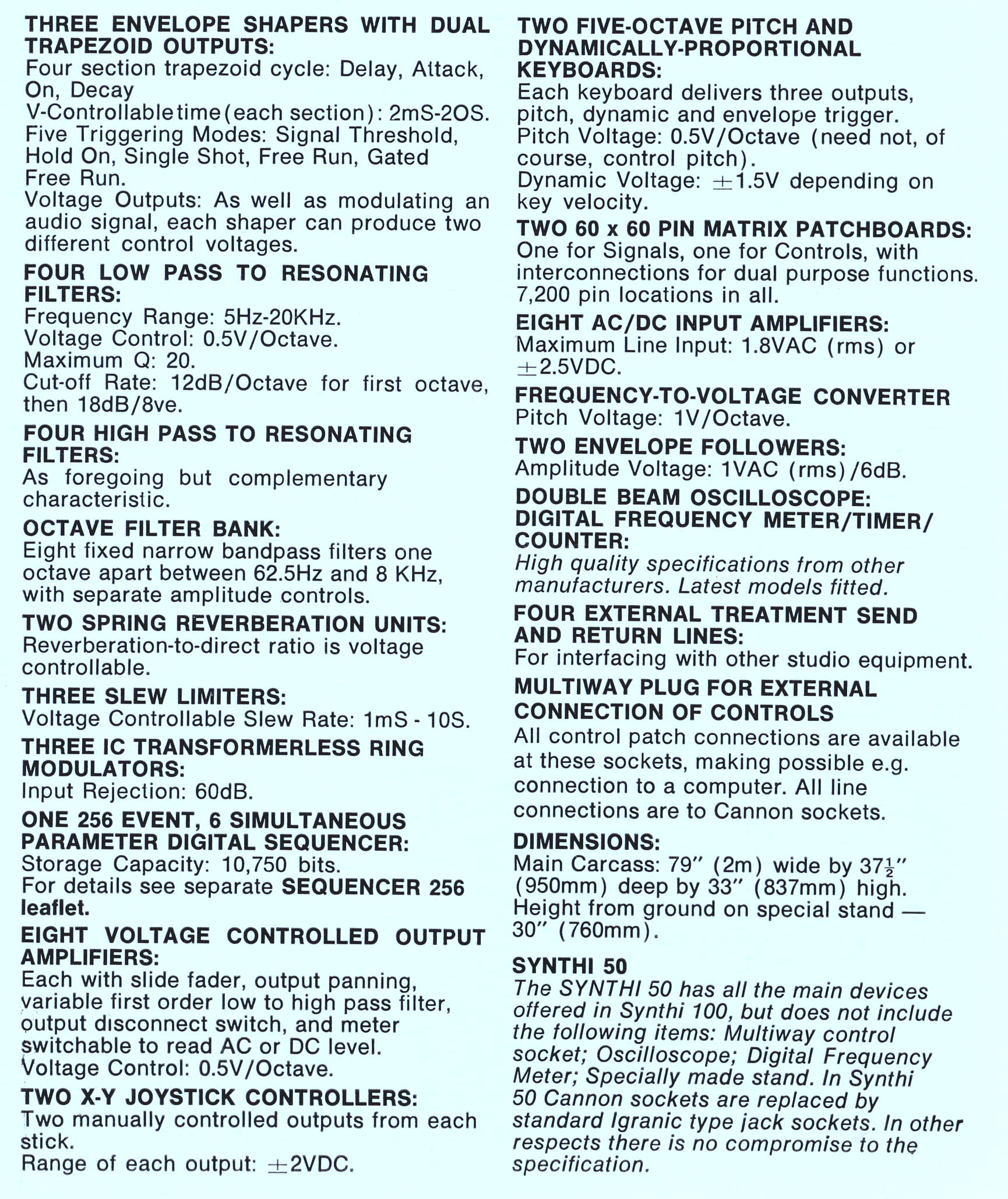
Unfortunately, David Cockerell had not written any operating instructions and was out of the country. We were told 'Just play with it. It's all pretty obvious!' I decided the best way for me to find my way around this monster was to give myself an artificial project. The Delaware was so huge it reminded me of a 'dance hall' organ and I decided to make a piece in the style of those wonderful Belgian mechanisms.
The 'Sequencer 256' [which was part of the Synthi 100] was a bit of a problem, but it transpired that there were three 'levels' to each recorded event. As each level remembered a control voltage, it could be configured in any way, but the normal set up was :-
Level 2: Dynamic (Loudness)
Level 3: On / Off (Return)
There was also a control called 'Option 4', which was not connected to anything, but became very useful in keeping interfering directors quiet. One thing that occurred to me was that the memorised voltages could be used to do other things. In this piece, the pitch voltages are also used to control the panning of the output amplifiers, so that the higher the note, the more to the right it is, and vice versa.
The Delaware's voltages were never very stable [it was a large machine, running hot in a small room without air conditioning], but I think that the drifts in tuning and timing add a certain archaic charm. Some concrète sounds are also included, the last of which is one of my favourites, an SU carburettor [which was part of petrol cars at the time].
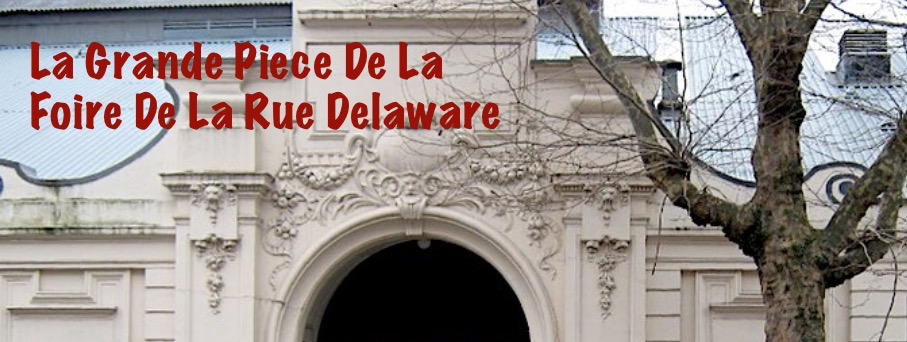
I had been working on 'War of the Worlds' with David Lyttle, a Schools Radio director. When he visited the Workshop in 1970, I showed him the then new Delaware synthesiser. What interested him most was its ability with sequenced sound to change pitch, without altering duration and to alter speed (tempo) without pitch change. (We were all still slaves to tape!) "This sort of thing is ideal for describing an animal's physical size and activity for young children, in terms of sound", he said.
He then asked me if I had time to experiment with this idea and, if so, I could I make up a simple sound story, for young children, to include size and action. This should be about four minutes long. I could use my own voice to narrate the story. The children's 'Sound Cartoon' - 'The Two Whales', was completed very quickly and broadcast in the 'Music and Movement' series the following month.

IEE CENTENARY
It came as a surprise and a shock when I was warned not to take on any more programme commitments as I only had one month of my attachment left. I desperately wanted to stay at the Workshop, but although Desmond Briscoe described me as a 'Square peg in a square hole', he pointed out that it was now a case of 'dead men's shoes' and the staff were all very young.
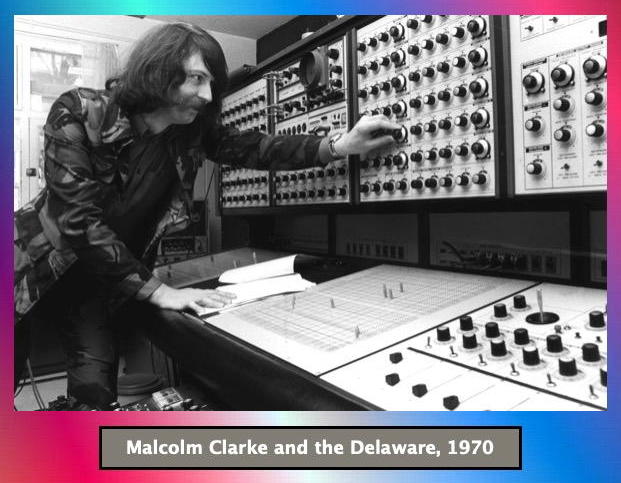
I was just starting my final week when nature intervened, and I found myself on the other side of the Harrow Road in St Mary's Hospital having my appendix removed. When I awoke from the anaesthetic, I was surprised to find messages and drawings painted on my abdomen. A friend of Delia's from Cambridge, Mr. Justin Kelly, had performed the operation. He was a pioneer in developing scar-free incisions and I bear this scar to today, but only just!
While I was at home in Finsbury Park, convalescing, I received a visit from Desmond, who told me that at the beginning of the following year, 1971, the Workshop had been requested to provide the entertainment for the centenary celebration of the IEE (Institute of Electrical Engineers).
It was going to be held at the Royal Festival Hall [in May of 1971] and attended by Her Majesty The Queen, the Duke of Edinburgh and Lord Mountbatten. We had been requested to make the entertainment as 'visual' as possible. Knowing of my interest in combining sound and image, he asked me if I would be interested in helping? Naturally, I said yes.

The Festival Hall performance was an amazing experience and included all of the Workshop's facilities, including the Delaware synthesiser, plus lasers, sound-to-light converters, specially-made film and numerous pyrotechnic effects. More important to me was the fact that as a result, I was offered a permanent post at the BBC Radiophonic Workshop.


©Malcolm Clarke 2003
